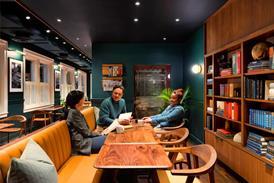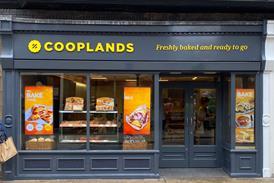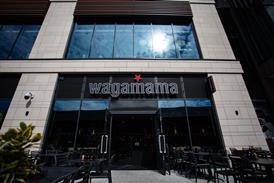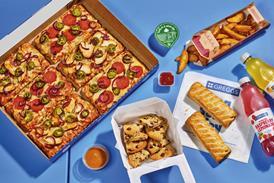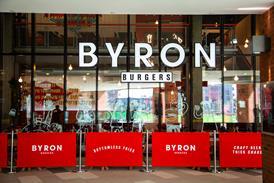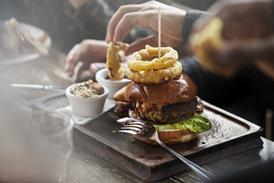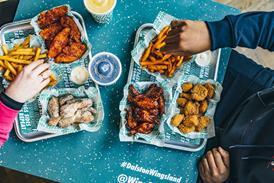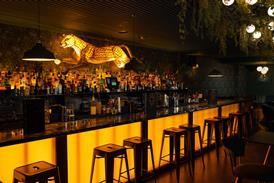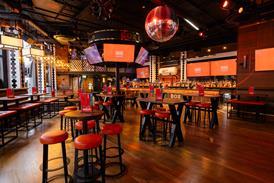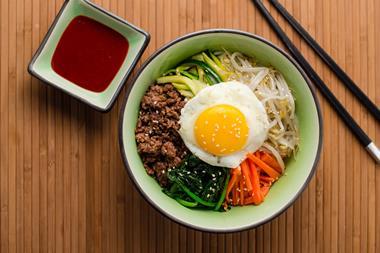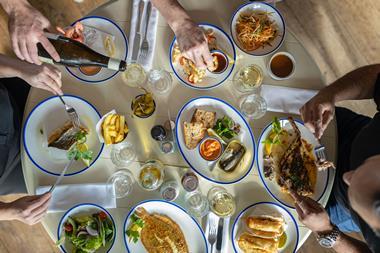Korean food is rapidly installing itself as mainstream force in the US eating out sector. Kerstin Kühn explores some of the established and emerging concepts in this field.
Korea is having its moment in the sun right now. And, it’s not just Moon Jae-in who has been grabbing headlines. Korean food has steadily been gaining popularity among Americans. Thanks to Los Angeles chef Roy Choi’s Kogi Korean food truck gaining cult status, and New York City’s Anthony Bourdain and David Chang popularising the country’s cuisine on television, Korean food is now as well known as sushi.
Kimchi for instance was, until recently, hardly a thing outside of Korean communities but now the pickled cabbage dish has become mainstream, not just on restaurant menus but also on supermarket shelves. Likewise, gochujang, a spicy-sweet fermented chilli paste, or doenjang, a fermented bean paste, are becoming increasingly widespread.
According to data from menu research firm Datassential, Korean ingredients are now mentioned on 5.2% of all US menus, constituting a 70% increase over the last five years. Consumers are ordering Korean food everywhere, including (TGI Friday’s) with Korean burgers and tacos now comprising a whole new genre of American fast food.
Korean barbecue spots have now become staples in most major cities and Korean fast-casual concepts are starting to pop up across the country. Their menus are as versatile and colourful as the country’s cuisine itself. Many concentrate on a single dish, such as the famous rice dish bibimbap, made with vegetables and marinated meat and often topped with a fried egg; or Korean fried chicken, which is dusted in cornstarch and double-fried. Here’s a look at five Korean operators to watch:
BIBIBOP ASIAN GRILL
THE CONCEPT: The undisputed fast-casual leader of Korean food, this 29-unit bibimbap chain from Columbus, Ohio, started in 2013. Last year, it more than doubled in size after buying the leases of 15 ShopHouse Southeast Asian Kitchen locations in Washington, DC, Chicago, Maryland, and Los Angeles from Chipotle, which abandoned the concept.
WHO’S BEHIND IT? Gosh Enterprises. Its founder Charley Shi is a native South Korean who launched Charleys Philly Steaks in 1985, which now has more than 500 locations worldwide.
WHAT’S ON THE MENU: Bibibop serves different varieties of bibimbap, the popular Korean mixed rice dish. Customers choose a base from white rice, purple wild rice, lettuce, sautéed potatoes or tortilla wraps and add a selection of proteins and vegetables including grilled chicken, steak, or tofu, as well as kale, carrots, corn, cheese, egg or daikon. A variety of sauces include spicy sriracha, Korean red sauce, teriyaki, and “yum yum” sauce, while sides include edamame, kimchi and miso soup.
AVERAGE SPEND: Under $10
BIBIGO
THE CONCEPT: Bibigo is a global brand, which first launched in the US in 2010 with plans to open 200 locations nationwide. It currently runs nine units in Southern California. The company is developing a new model, which is expected to open towards the end of this year.
WHO’S BEHIND IT: Korean food conglomerate CJ Foodville a division of the CJ Group, Korea’s largest food manufacturer. It gets its name from a mash-up of Korean bi-bi-da (“to mix”) and English “to-go”.
WHAT’S ON THE MENU: Bibigo also takes the classic bibimbap dish and allows diners to customise it according to their wishes. Customers choose whether to have their meal in a bowl, a hot stone, or in a larger box with more protein and a side of fried dumplings. They then pick from various options of rice, noodles or salad and toppings such as a range of vegetables and proteins including the classic bulgogi beef, short ribs, galbi chicken, spiced pork or tofu. There are six sauces available, including sesame and hot sauce and citron-soy and yellow curry.
AVERAGE SPEND: $10
GOGI GRILL
THE CONCEPT: First launched in New Jersey in 2016, Gogi Grill currently operates two units in Hoboken, NJ, and in Chelsea, Manhattan. The company is actively looking for a third site, also exploring Boston, Philadelphia, and Washington, D.C, and hopes to sell its first franchise this year.
WHO’S BEHIND IT: Founder Inku Yo is a Korean-American who grew up in Massachusetts learning about Korean food from his mother’s home cooking. However, when he moved to New York City, he found the restaurants in Koreatown to be intimidating and decided to open a restaurant that makes authentic Korean food accessible to the masses.
WHAT’S ON THE MENU: Diners choose their own style of meal from bowl, burrito, salad or tacos, then customise the dish with rice (white, purple, fried or kimchi) or japchae (Korean glass noodles) as well as a protein, vegetable toppings and a sauce. Protein choices include beef short rib, pork belly, grilled shrimp, spicy chicken and bulgogi. There are four sauces: red (Korean gochujang), brown (Japanese katsu), green (Mexican cilantro-lime jalapeño) or teriyaki.
AVERAGE SPEND: Above $10
SEOUL TACO
THE CONCEPT: Founded in St. Louis, Missouri, in 2011, the five-strong Seoul Taco operates outlets in Chicago and Champaign, Illinois, and the Missouri cities of Columbia, Chesterfield and St. Louis.
WHO’S BEHIND IT? The chef owner David Choi may have no relation to Roy Choi, whose Kogi BBQ truck in Los Angeles kick-started both the food truck and Korean food revolution but, just like his namesake, he too started Seoul Taco as a food truck and also serves Korean flavors by way of well known Mexican dishes.
WHAT’S ON THE MENU: Seoul Taco fuses Korean and Mexican cuisines in creations like its signature Seoul Taco Burrito, which is stuffed with kimchi fried rice, lettuce, cheese, carrots, green onions, sour cream, signature “Seoul sauce” and a choice of bulgogi beef, spicy pork, chicken or seasoned tofu. Tacos, quesadillas and nachos are also on the menu, topped with Korean staples like green onions, sesame seeds and kimchi, as well as Tex-Mex ingredients such as cheese and sour cream.
AVERAGE SPEND: Under $10
INJOI KOREAN KITCHEN
THE CONCEPT: Launched in Denver, Colorado, in March this year, this newcomer to the fast-casual Korean landscape is slightly more upmarket than its competitors. It is housed in Zeppelin Station, a 100,000 sq ft workspace and food hall, with an 11-strong food and beverage line up.
WHO’S BEHIND IT? Owner William Espiricueta was executive sous chef at renowned restaurants Oak at Fourteenth in Boulder, and its sister restaurant Acorn in Denver. His fast-casual concept also draws influence from his barbecue background and focuses on Korean comfort food.
WHAT’S ON THE MENU: The signature fried chicken is double-fried but in addition to the traditional Korean cornstarch also includes Southern breading. It is served plain or with a range of spicy dry rubs and sauces. Other options include a rice noodle bowl, bibimbap topped with fried chicken tenders, beef bulgogi, a house salad and the Rocket Man Sandwich made with two chicken tenders, slaw, pickled cucumbers and hot or extra-hot sauce. Side dishes include steamed rice and two types of kimchi while add-ons such as Korean barbecue brisket and crispy tofu are also available.
AVERAGE SPEND: Above $10
Kerstin Kühn is a journalist specialising in the US hospitality sector

